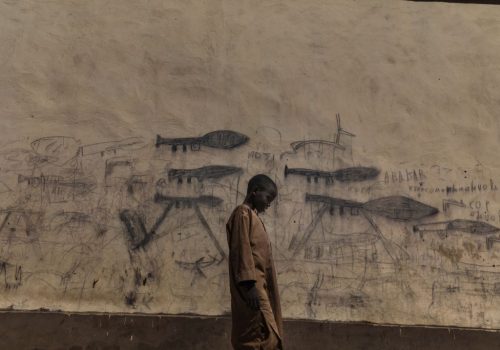Resilient is an exhibition (at Forma Meravigli, in Milan), a book (published by Contrasto), but above all the testimony of a world – the African world –that is able to cope, reorganize and react despite the crises that mark it.
The author, is Marco Gualazzini, collaborator of the Contrasto agency and one of the nominees for the World Press Photo as well as for the World Press Photo Story of the Year 2019. L’Œil de la Photographie is interviewing him, while waiting to know the winners and the best pictures contributing to the past year of visual journalism
War correspondent Domenico Quirico, referring to Gualazzini’s photos says their “content is so striking, so all-embracing, so absolute that any description would be superfluous”. This is the case with the nominee Almajiri Boy, that is part of the reportage on The Lake Ciad Crisis, representingan orphaned boy walking past a wall with drawings depicting rocket-propelled grenade launchers.“The ongoing humanitarian crisis in the Chad Basin is caused by a complex combination of political conflict and environmental factors, including massive desertification of the Lake Chad (its size has decreased by 90 percent over the past 60 years) and terrorism by the Jihadist group Boko Haram”, Gualazzini explains.
LODP: Why did you start taking pictures like this?
M.G.:. My own background was connected to journalism as my father used to be a correspondent for the newspaper founded by Montanelli. Moreover I travelled a lot with my parents to developing countries and I became more and more interested in journeying in the “other world”- as Kipling called it – trying to deeply understand its values, problems and tragedies. Then, while I was taking courses in Conservation of Cultural Heritage, I met Gianluigi Colin. As a teacher, he opened up new perspectives on photography and on photo journalism. It was the ‘90s and he was showing us the reportages by Nachtwey and by Gilles Peress, while telling us about the then ongoing humanitarian crises. This very mix is the reason for my photos.
LODP: Do you think photography can be a means for better understanding a different culture?
M.G.: It looked like photography was a way of satisfying my fascination with world, kind of justification to travel to those countries with a non-turism attitude. Furthermore, as I’m very reserved, I was using my camera as a cover, in order to deal with certain situations actively, though not in a voyeuristic way.
LODP: You describe yourself as an outside observer, but thanks to photography you managed to enter many “other worlds”. How did you do it?
M.G.: On my first trips I didn’t manage to shoot interesting photos. At the time even getting to Afghanistan seemed a goal to me. But one thing is going to a country and quite another is working there. My next experience as a photo reporter for the daily paper of my native town, La Gazzetta di Parma, taught me about news values. I also started working on logistical preparation, as I understood the significance of preparatory work in order to do my work properly. If you go to Congo or to Somalia you immediately are immersed in tragic situations. But if you want to delve deeper into them, you need someone who opens doors for you. These are the fixers, often local journalists as well as met by chance people. For instance, while I was covering the M23 conflict in Congo, my driver was also my fixer. He was called papa Gustav. Well-respected and trusted , he managed to let me get involved in – too often tragic –situations.
LODP: Your photos, even when dealing with suffering and tragedy, seem to open up to a possible future
M.G.: Well, maybe so. Some photo journalists prefer to photograph their subjects up close. And so do I, but I take a step back too. I don’t want to sensionalize the tragedy aiming for compassion. I prefer to tell stories that helps understand what’s happening, that, as a civil testimony, can raise public awareness. Maybe a reason for this attitude is owed to the people who accompanied me on my first reportages. They were missionaries, who have devoted their lives to the people of these countries. So I figured that if everything’s gone there would have no point in acting in situations such as these ones nor telling about them. But they were acting. Maybe all of the above is the basis for Resilient, telling stories of resilience to testify the ability of a system to cope positively with traumatic events, such as Africa’s amazing and dramatic capacity to respond to crises.in spite of everything”.
The exhibition, curated by Alessandra Mauro, is showing some 40 images from the reportages Gualazzini carried out in Africa (2009 – 2018). The book Resilient is published by Contrasto/Roberto Koch Editore with contributions by Domenico Quirico e Gianluigi Colin.
Paola Sammartano
Paola Sammartano is a journalist specialized in arts and photography based in Milan, Italy
Marco Gualazzini – Resilient
From 31 January to 24 March 2019
Forma Meravigli
Via Meravigli 5, Milan
Italy
















